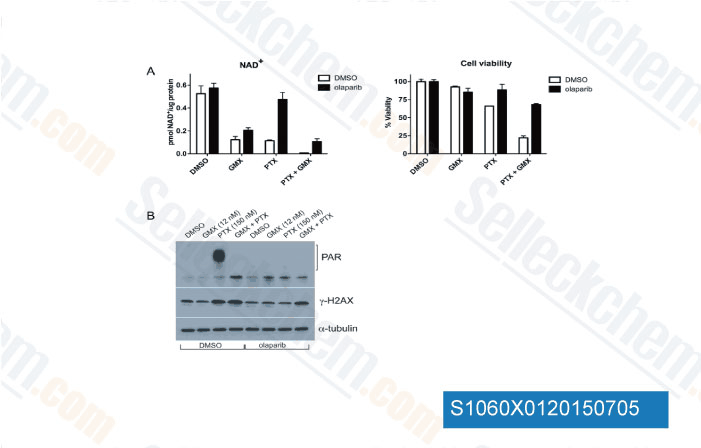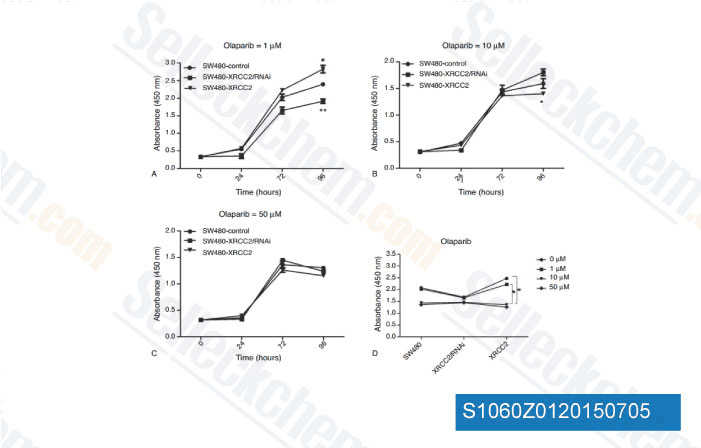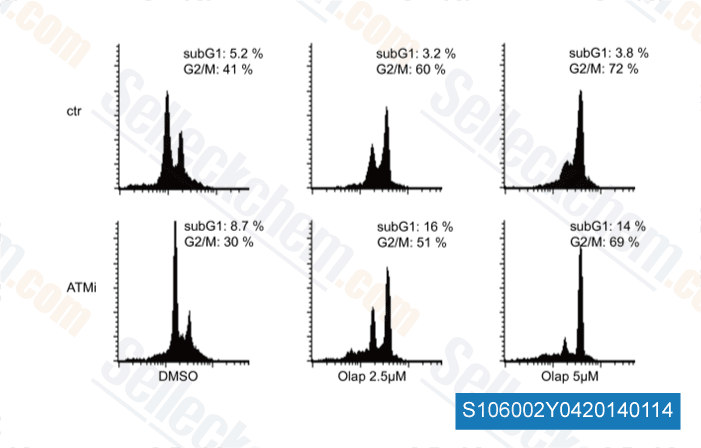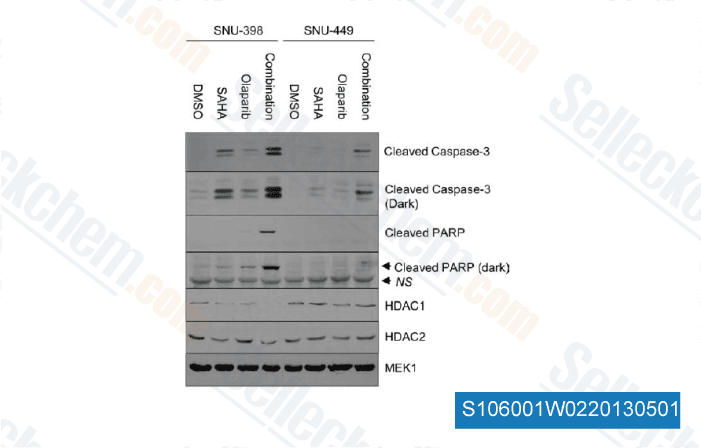|
Toll Free: (877) 796-6397 -- USA and Canada only -- |
Fax: +1-832-582-8590 Orders: +1-832-582-8158 |
Tech Support: +1-832-582-8158 Ext:3 Please provide your Order Number in the email. |
Technical Data
| Formula | C24H23FN4O3 |
|||
| Molecular Weight | 434.46 | CAS No. | 763113-22-0 | |
| Solubility (25°C)* | In vitro | DMSO | 87 mg/mL (200.24 mM) | |
| Water | Insoluble | |||
| Ethanol | Insoluble | |||
|
* <1 mg/ml means slightly soluble or insoluble. * Please note that Selleck tests the solubility of all compounds in-house, and the actual solubility may differ slightly from published values. This is normal and is due to slight batch-to-batch variations. * Room temperature shipping (Stability testing shows this product can be shipped without any cooling measures.) |
||||
Preparing Stock Solutions
Biological Activity
| Description | Olaparib (AZD2281, KU0059436) is a selective inhibitor of PARP1/2 with IC50 of 5 nM/1 nM in cell-free assays, 300-times less effective against tankyrase-1. Olaparib induces significant autophagy that is associated with mitophagy in cells with BRCA mutations. | ||||
|---|---|---|---|---|---|
| Targets |
|
||||
| In vitro | Olaparib would act against BRCA1 or BRCA2 mutations. Olaparib is not sensitive to tankyrase-1 (IC50 >1 μM). Olaparib could ablate the PARP-1 activity at concentrations of 30-100 nM in SW620 cells. Olaparib is hypersensitive to BRCA1-deficient cell lines (MDA-MB-463 and HCC1937), compared with BRCA1- and BRCA2-proficient cell lines (Hs578T, MDA-MB-231, and T47D). [1] Olaparib is strongly sensitive to KB2P cells due to suppression of base excision repair by PARP inhibition, which may result in the conversion of single-strand breaks to double-strand breaks during DNA replication, thus activating BRCA2-dependent recombination pathways. [2] | ||||
| In vivo | Combining with temozolomide, Olaparib (10 mg/kg, p.o.) significantly suppresses tumor growth in SW620 xenografts. [1] Olaparib shows great response to Brca1-/-;p53-/- mammary tumors (50 mg/kg i.p. per day), while no responses to HR-deficient Ecad-/-;p53-/- mammary tumors. Olaparib even does not show dose-limiting toxicity in tumor-bearing mice. [3] Olaparib has been used to treat with BRCA mutated tumors, such as ovarian, breast and prostate cancers. Moreover, Olaparib shows selectively inhibition to ATM (Ataxia Telangiectasia Mutated)-deficient tumor cells, which indicates to be a potential agent for treating ATM mutant lymphoid tumors. [4] | ||||
| Features | A potent PARP inhibitor (currently in late stage clinical trials). |
Protocol (from reference)
| Kinase Assay: |
|
|---|---|
| Cell Assay: |
|
| Animal Study: |
|
References
Customer Product Validation

-
Data from [Data independently produced by Cancer Res, 2014, 74(21), 5948-54]

-
Data from [Data independently produced by Medicine (Baltimore), 2014, 93(28), e294]

-
Data from [J Exp Clin Cancer Res, 2013, 32(1), 95]

-
Data from [Hepatology, 2012, 55, 1840-1851]
Selleck's Olaparib (AZD2281) has been cited by 1216 publications
| Transcription-replication conflicts underlie sensitivity to PARP inhibitors [ Nature, 2024, 10.1038/s41586-024-07217-2] | PubMed: 38509368 |
| PARP1-DNA co-condensation drives DNA repair site assembly to prevent disjunction of broken DNA ends [ Cell, 2024, 187(4):945-961.e18] | PubMed: 38320550 |
| FLIP(C1orf112)-FIGNL1 complex regulates RAD51 chromatin association to promote viability after replication stress [ Nat Commun, 2024, 15(1):866] | PubMed: 38286805 |
| Targeting EMSY-mediated methionine metabolism is a potential therapeutic strategy for triple-negative breast cancer [ Cell Rep Med, 2024, 5(2):101396] | PubMed: 38290515 |
| DNA damage remodels the MITF interactome to increase melanoma genomic instability [ Genes Dev, 2024, 38(1-2):70-94] | PubMed: 38316520 |
| Poly(ADP-ribosyl)ation of TIMELESS limits DNA replication stress and promotes stalled fork protection [ Cell Rep, 2024, 43(3):113845] | PubMed: 38393943 |
| The ARID1A-METTL3-m6A axis ensures effective RNase H1-mediated resolution of R-loops and genome stability [ Cell Rep, 2024, 43(2):113779] | PubMed: 38358891 |
| CASK Mediates Oxidative Stress-Induced Microglial Apoptosis-Inducing Factor-Independent Parthanatos Cell Death via Promoting PARP-1 Hyperactivation and Mitochondrial Dysfunction [ Antioxidants (Basel), 2024, 13(3)343] | PubMed: 38539876 |
| PARP1, DIDO3, and DHX9 Proteins Mutually Interact in Mouse Fibroblasts, with Effects on DNA Replication Dynamics, Senescence, and Oncogenic Transformation [ Cells, 2024, 13(2)159] | PubMed: 38247850 |
| Type III secretion system effector YfiD inhibits the activation of host poly(ADP-ribose) polymerase-1 to promote bacterial infection [ Commun Biol, 2024, 7(1):162] | PubMed: 38332126 |
RETURN POLICY
Selleck Chemical’s Unconditional Return Policy ensures a smooth online shopping experience for our customers. If you are in any way unsatisfied with your purchase, you may return any item(s) within 7 days of receiving it. In the event of product quality issues, either protocol related or product related problems, you may return any item(s) within 365 days from the original purchase date. Please follow the instructions below when returning products.
SHIPPING AND STORAGE
Selleck products are transported at room temperature. If you receive the product at room temperature, please rest assured, the Selleck Quality Inspection Department has conducted experiments to verify that the normal temperature placement of one month will not affect the biological activity of powder products. After collecting, please store the product according to the requirements described in the datasheet. Most Selleck products are stable under the recommended conditions.
NOT FOR HUMAN, VETERINARY DIAGNOSTIC OR THERAPEUTIC USE.
